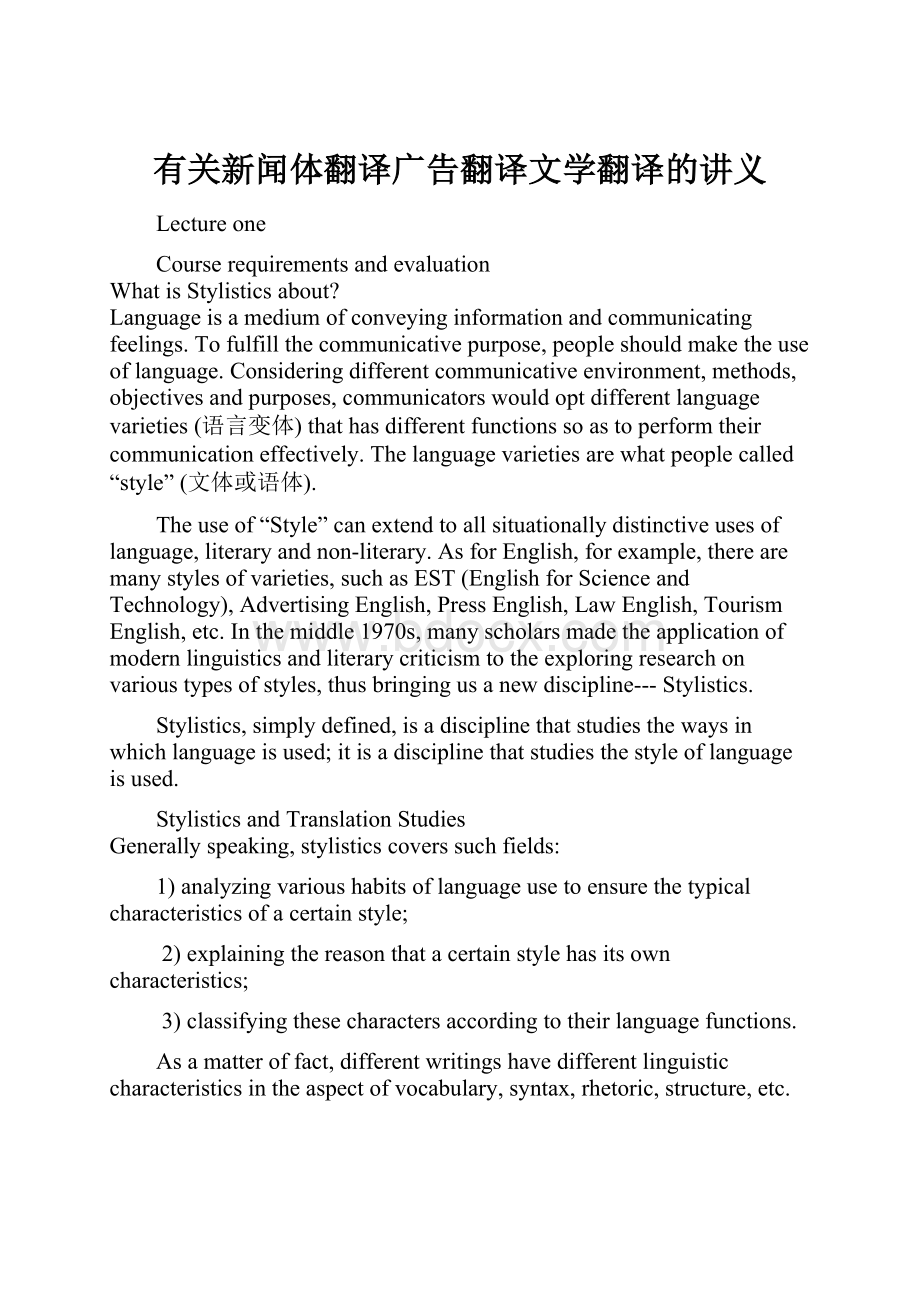有关新闻体翻译广告翻译文学翻译的讲义.docx
《有关新闻体翻译广告翻译文学翻译的讲义.docx》由会员分享,可在线阅读,更多相关《有关新闻体翻译广告翻译文学翻译的讲义.docx(58页珍藏版)》请在冰豆网上搜索。

有关新闻体翻译广告翻译文学翻译的讲义
Lectureone
Courserequirementsandevaluation
WhatisStylisticsabout?
Languageisamediumofconveyinginformationandcommunicatingfeelings.Tofulfillthecommunicativepurpose,peopleshouldmaketheuseoflanguage.Consideringdifferentcommunicativeenvironment,methods,objectivesandpurposes,communicatorswouldoptdifferentlanguagevarieties(语言变体)thathasdifferentfunctionssoastoperformtheircommunicationeffectively.Thelanguagevarietiesarewhatpeoplecalled“style”(文体或语体).
Theuseof“Style”canextendtoallsituationallydistinctiveusesoflanguage,literaryandnon-literary.AsforEnglish,forexample,therearemanystylesofvarieties,suchasEST(EnglishforScienceandTechnology),AdvertisingEnglish,PressEnglish,LawEnglish,TourismEnglish,etc.Inthemiddle1970s,manyscholarsmadetheapplicationofmodernlinguisticsandliterarycriticismtotheexploringresearchonvarioustypesofstyles,thusbringingusanewdiscipline---Stylistics.
Stylistics,simplydefined,isadisciplinethatstudiesthewaysinwhichlanguageisused;itisadisciplinethatstudiesthestyleoflanguageisused.
StylisticsandTranslationStudies
Generallyspeaking,stylisticscoverssuchfields:
1)analyzingvarioushabitsoflanguageusetoensurethetypicalcharacteristicsofacertainstyle;
2)explainingthereasonthatacertainstylehasitsowncharacteristics;
3)classifyingthesecharactersaccordingtotheirlanguagefunctions.
Asamatteroffact,differentwritingshavedifferentlinguisticcharacteristicsintheaspectofvocabulary,syntax,rhetoric,structure,etc.
AccordingtolinguistsBulerandJackbson,therearethreefunctionsoflanguage:
expressivefunction,informativefunction,andvocativefunction.Anyoriginalworkhasthethreefunctions.
JustasNewmarksays,“Themainfunctionsoflanguageareexpressive(thesubjectiveor“I”form),thedescriptiveorinformative(the“it”form),andthevocativeordirectiveorpersuasive(the“you”form).Alltextshaveaspectsoftheexpressive,theinformativeandthevocativefunction.
Generallyspeaking,literaryworkmainlyfocusesontheexpressivefunction,whilenon-literaryworksmainlycenteroninformativefunctionandvocativefunction.ComparethedifferencesofEnglishforAdvertisingandLiterarywork,forexample.Nowtheexamples:
1.Helaughsbestwhorunslongest.
谁跑到最后,谁笑得最好。
(轮胎广告)
2.InMiami,it’snonovelty.游了迈阿密,才知天下奇。
3.Somefishingboatswerebecalmedjustinfrontofus.Theirshadowsslept,oralmostslept,uponthewater,agentlequiveringaloneshowingthatwasnotcompletesleeporifsleep,thatiswassleepwithdream.
眼前不远,渔舟三五,凝滞不前,樯影映在水上,仿佛睡去,偶尔微见颤动,似又未尝熟睡,恍若惊梦。
4.Portia:
Andyoumustcutthisfleshfromoffhisbreast.Thelawallowsit,andthecourtawardsit.
Shylock:
Mostlearnedjudge!
Asentence!
Come,prepare!
(Excerptedfrom:
ActIV,TheMerchantofVenice,byWilliamShakespeare)
鲍西娅:
你必须从他的胸前割下这磅肉来;法律许可你,法庭判给你。
夏洛克:
博学多才的法官!
判得好!
来,预备!
Itisveryimportantforustointroducestylisticsintotranslationstudy.WhycanStylisticsbeappliedtotranslationstudy?
Itliesinthatbothofthemhavethesameaim,thatis,howtofulfillsocialcommunicationwitheffectivelinguisticmethods.
Theybothputemphasisonthesocialstandardofcommunicativefunction;theydon’tignorethetimelinessandindividualityofwritingstyleaswell.
Intheprocessoftranslation,itisnecessaryfortranslatortodealwithhistranslationcarefullyinordertomakethetranslationaccordwiththesourcetextintheaspectofstyle.Nowforsomeexamples:
5.Graspall,loseall.
Version1:
如果你样样都要抓,就会一样都抓不到手。
Version2:
样样抓,样样差。
(贪多必失)
Asfortranslationofdifferenttypesofwriting,thekeywordis“equivalence”.Concretelyspeaking,therearefouraspectsof“equivalence”,theyare:
1.Equivalenceofsemanticmessageofsourcelanguageandtargetlanguage.(原文的语义信息与译文的语义信息对等)
2.Equivalenceofstylisticmessageofsourcelanguageandtargetlanguage.(原文的风格信息与译文的风格信息对等)
3.Equivalenceofculturalmessageofsourcelanguageandtargetlanguage.(原文的文化信息与译文的文化信息对等)
4.Equivalenceofresponseofsourcelanguagereadersandtargetreaders.(原文的读者反应与译文的读者反应对等)
Exercise
Translatethesetermsorsentencesofdifferentwritings.
1.irrevocableletterofcredit
Heinsistedonanirrevocableletterofcredit.
2.finefood,mostattractivesurroundingsandafriendlydisposition.
3.Ifpeoplekeeptellingyoutoquitsmokingcigarettes,don’tlisten…They’reprobablytryingtotrickyouintoliving.
4.Moreoften,theheartdiseaseprocessprogressessilentlyuntilsymptomsoccurbecausethepumpisnotsupplyingbloodinsufficientquantitytootherorgans.
1.不可撤消信用证(指除非信用人同意,信用证不得撤消)他坚持只接受不可撤消信用证。
2.饭菜上乘,环境幽雅,服务一流。
3.凡劝您戒烟的人,一概莫理---他们就想骗您再多活几年。
4.更常见的是,这种心脏病在发作过程中并无症状,后来发生症状是因为心脏不能给其他器官供应充足的血液。
LectureTwo
ABriefIntroductiontoTranslationTheory
PrerequisitesforBeingaTranslator
(1)Masteryofbothsourcelanguage(原语)andtargetlanguage(译语).
(2)Understandingofculturalbackground,nationalcharacterandcustoms.
(3)Practicemakesperfect.
Functionsoftranslation
tohelppeoplebettercommunicatewithoneanother
tofacilitatethedevelopmentofcultureandcivilizationofallnations
topromoteglobaleconomicandculturaldevelopment
toenrichtheideasandexpressionsofthetargetlanguage
Translationasanartorascience
Translationisbothanartandascienceaswell,sinceitcallsforagoodcommandofatleasttwolanguages,aflexibleapplicationoftheirrules,andsomeknowledgeofatleasttwocultures,aswellasagoodgraspofthenecessarytranslationtheories.
Principlesfortranslationandcriteriafortranslation
Theyareactuallyidenticalinessence,theonlydifferencebetweenthetwotermslyinginthefactthattheformerisobservedfromtheperspectiveofthetranslator,whilethelatterisexaminedfromtheangleofthetranslationcritic.
CriteriaforTranslation
1.InChina1).严复(1898)的“信,达,雅”faithfulness,expressivenessandelegance
“Faithfulness”meansthefullandcompleteconveyingoftheoriginalcontentofthought;
“Expressiveness”demandsthattheversionshouldbeclearandflowingwithoutanygrammaticalmistakesorconfusedlogicandsense;“Elegance”referstotheuseofclassicalChinesebeforetheHanDynasty.
2).鲁迅的“忠实,通顺”faithfulnessandsmoothness
FaithfulnessreferstothatcontentandstyleofTLshouldbefaithfultotheSL.
Smoothnessrequiresthatversionshouldbeclearanddistinct,flowingandeasytoreadwithoutsignsofthemechanicalword-for-wordtranslation,ofobscurelanguage,ofgrammaticalmistakes,confusedstructureandlogic.
3).傅雷(1951)的(文学翻译)“传神”论similarityinspirit
TLshouldbesimilartoSLbothinFormandinSpirit.
4).钱钟书(1964)的“化境”说transfiguration
5).刘重德(1979)“faithfulness(信),expressiveness(达)andcloseness(切)”,
faithfulness:
tobefaithfultothecontentoftheoriginal;
expressiveness:
tobeasexpressiveandsmoothastheoriginal;
closeness:
tobeasclosetotheoriginalstyleaspossible.
2.Westerntranslationtheory
1).A.F.Tytler’sThreePrinciplesoftranslation
a.Thatthetranslationshouldgiveacompletetranscriptoftheideasoftheoriginalwork.
b.Thatthestyleandthemannerofwritingshouldbethesamecharacterwiththatoftheoriginal.
c.Thatthetranslationshouldhavealltheeaseoforiginalcomposition.
2)E.A.Nida’sFunctionalEquivalence
Equivalenceisacentralconceptintranslationtheory,butitisalsoacontroversialone.
Translationconsistsinreproducinginthereceptorlanguagetheclosestnaturalequivalentofthesourcelanguagemessage,firstintermsofmeaningandsecondlyintermsofstyle.(所谓翻译,是指从语义到文体上在译语中用最切近而且最自然的对等语再现原语的信息。
)(NidaandTaber,1982)
3)PeterNewmark’SemanticTranslationandCommunicativeTranslation
Semantictranslation:
Thetranslatorattempts,withinthebaresyntacticandsemanticconstraintsoftheTL,toproducetheprecisecontextualmeaningoftheST.Semantictranslationfocusesprimarilyuponthesemanticcontentofthesourcetext.
Communicativetranslation:
ThetranslatorattemptstoproducethesameeffectontheTLreadersaswasproducedbytheoriginalontheSLreaders.Communicativetranslationfocusesessentiallyuponthecomprehensionandresponseofreceptors.
4)SkoposTheory
(Vermeer1978,ChristianeNord1988)
SkopostheoryisanapproachtotranslationwhichwasdevelopedinGermanyinthelate1970s,andwhichreflectsageneralshiftfrompredominantlylinguisticandratherformaltranslationtheoriestoamorefunctionallyandsocioculturallyorientedconceptoftranslation.
Lecturethree
TranslationTechnique
Literaltranslation&Free/liberaltranslation直译与意译
achoiceonwhethertoretainformandstructurebasedonexpressivenessandsmoothness
Literaltranslation:
anadequaterepresentationoftheoriginal,especiallywhentheoriginalcoincidencewiththetargetlanguage.
Free/liberaltranslation:
nostrictadherencetotheformorwordorderoftheoriginal.
E.g.Whokeepscompanywiththewolfwilllearntohowl.与狼为伍将学会狼嗥。
近朱者赤,近墨者黑。
Oneswallowdoesnotmakeasummer.一只燕子不能造成夏季。
一燕不成夏。
偏不概全。
Heisbetweenthedevilandthedeepsea.他在魔鬼与深海之间。
他进退两难。
Heneedstopullarabbitoutofhishat.他需要拿出一个绝招来(直译:
他需要从自己的帽子里抓出一只兔子来)
Transliteration音译:
therepresentationofforeignpronunciationsinTL,especiallyusedforpropernouns,terms,etc.
胡同、气功、台风、秧歌、舢板hutong,qigong,typhoon,yangko,sampan
豆腐、馄饨、大饼tofu,huntun,dabin
Oftenusedwithothertechniques!
!
!
虎跑泉、景德镇、唐明皇HupaoSpring,JingdezhenCity,EmperorTangMingHuang
Foreignization&Domestication异化与归化:
Foreignization:
Ifthetranslator